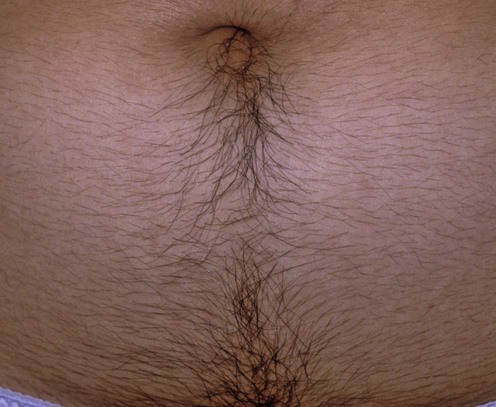Hypertrichosis and hirsutism
![]() For additional online content visit Expert Consult website.
For additional online content visit Expert Consult website.

Management strategy
Table 106.1
Ovarian
Polycystic ovarian syndrome (menstrual irregularities, infertility and metabolic syndromea)
HAIR-AN syndrome (hyperandrogenism, severe metabolic syndrome,a acanthosis nigricans)
Hyperthecosis (menstrual irregularities and metabolic syndromea)
Ovarian tumors and hyperplasia (irregular menses, virilization symptoms)
Adrenal
Congenital adrenal hyperplasia – classical and non-classical types (irregular menses, primary amenorrhoea)
Cushing’s syndrome (striae, fat redistribution, fragile skin, proximal muscle weakness, mood disturbance, insulin resistance)
Adrenal tumors (virilization symptoms)
Pituitaryb
Cushing’s disease (striae, fat redistribution, fragile skin, proximal muscle weakness, mood disturbance, insulin resistance)
Acromegaly (coarse facies and enlarged hands)
Hyperprolactinemia (galactorrhea )
Idiopathic
Occult functional hyperandrogenism
Abnormalities in peripheral 5α-reductase or androgen receptor
Exogenous (androgenic medications)
Testosterone, adrenocorticotrophic hormone (ACTH), valproic acid, anabolic steroids, androgenic progestins
aMetabolic syndrome: obesity, insulin resistance/diabetes mellitus type 2, lipid abnormalities, cardiovascular disease.
bPituitary tumors can also present with visual field disturbances.
First-line therapies
Treat specific underlying pathology.















 Weight loss if obese with PCOS
Weight loss if obese with PCOS Electrolysis
Electrolysis Temporary hair removal/camouflage
Temporary hair removal/camouflage Laser therapy and IPL
Laser therapy and IPL Eflornithine
Eflornithine Oral contraceptives
Oral contraceptives Spironolactone
Spironolactone Cyproterone acetate
Cyproterone acetate Finasteride
Finasteride Flutamide
Flutamide Insulin lowering monotherapy
Insulin lowering monotherapy Gonadotropin releasing hormone agonist analogs
Gonadotropin releasing hormone agonist analogs